
|   |

|   |
 e-mail: ukb7@rediffmail.com Music of the Spheres Photos courtesy the artistes February 14, 2020 It is not often that our classical dancers leave their beaten paths and refrain from executing the set routine of their forms but, rather, turn within and listen to their innermost hearts. This is akin to harking back to the ancient Greek notion - prevalent till the Renaissance --- that Sun, Moon and planets all emit their own unique celestial music physically inaudible to the human ear but, nonetheless, perceived by the sensitive soul. Is not the yearning for this ineffable Harmony of the Spheres echoed by PB Shelley while closing his 1821 ode to immanent love: The desire of the moth for the star / The night for the morrow / The devotion to something afar / From the sphere of our sorrow...? Katha Angika presented on January 28 attempted to turn on the above idea, namely, persuading a few seasoned classical dancers to listen to their inner calling. Nandanik Movement of Arts is a collaborative venture between leading classical dancers and theatre practitioners, and explores annually such new themes, structures and forms in dance and theatre through the medium of story-telling and other means. As they elaborate, "Dance for us, is not just a series of movements which covers space with time aesthetically, it also has the power to connect mind with soul, connect a performer to a spectator without any restriction of language. Rasikas realise Katha with Angika through the dance presentation which make them a part of the performance and not mere spectators. Using the medium of dance as communication, we come together, to celebrate the festival - Katha Angika". 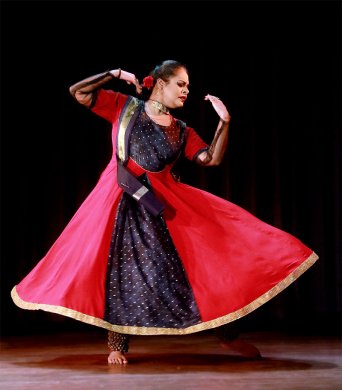 Anurekha Ghosh 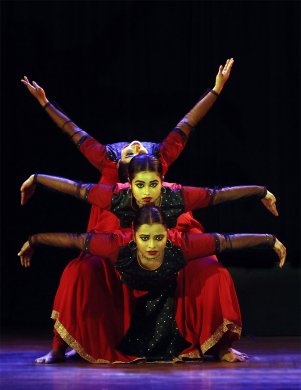 Anurekha Ghosh's group This year's efforts began with a robust rendering of Kathak setting the tone. Doing away with Kathak's usual trappings of a public address system and discarding even the yards of anklet-bells worn below the knees, the four female dancers led by Anurekha Ghosh, launched Niratata Dhang, composed by the renowned guru Durga Arya, freely blending a Meera Bhajan in raga Yaman within a Bindadin composition. The composition imagined Krishna's love play with Radha in refreshingly vigorous, synchronized steps and incorporating all the traditional components of Kathak, without making the latter a visual exercise of demonstration. This was followed by Talash Mein, the reminiscences of a lonely dancer, searching through the remnants of what had once been a gorgeous palace: I close my eyes, and these broken pieces surrounding me all come alive...I go back to a time when, as a court dancer, I performed in these royal halls...I re-live their brilliance, their sensuality, the ecstasy of the by-gone era... Set to the evocative music of Atul Desai of Kadamb fame, Anurekha's solo created the right ambience. The final piece was Illusions, focusing on the process of fragmentation and evolution, and inspiring future generations to rise towards a new beginning. The group choreography by Anurekha, with music by Pt. Ronu Majumdar and rhythm composition by Parthasarathi Mukherjee, was brilliantly conceived.  Mohana Iyer and Priyadarshini Ghosh Dwaita, the second item was set in Mohiniattam, where Priyadarshini Ghosh and Mohana Iyer with their group went in their quest, right to the Nasadiya Sukta, from the tenth mandala of the Rig Veda's Hymn of Creation. The hymn did not view the cosmos as the handiwork of an anthropomorphic god but more as a natural phenomenon. Even that could not be known, as all sentient beings (including the deities) came into existence afterwards. There was neither existence nor non-existence, so how could anyone know? How did it all begin? Would it ever be known? In a brave attempt, the seven shlokas reverberated with edakka music, setting the pace of the undulating Mohiniattam torsos of the eight female dancers, yearning to understand the very act of Creation. The group followed up with Adi Shankaracharya's Ardhanariswara Stotra using the eight dancers' bodies to create multiple binary patterns of the male-female duality. 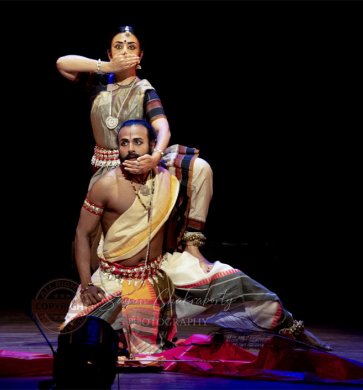 Kunti Kaunteya Katha If Kathak had hinted at innovations and illusions and Mohiniattam had gone right back to the primordial creation, there came Odissi in Kunti Kaunteya Katha to re-imagine perhaps the most complex feminine entity of the Mahabharata: Kunti the Queen. Daring to invite Surya to unite with her prior to her marriage, she proceeded with extra-marital liaisons with Dharma, Indra, Pavan and the Ashwini Brothers. Prince Karna, Kunti's first son - conceived while still a virgin - and discarded by her to avoid social shaming, was the other heroic character that was forever marginalized and vilified in the epic. The rare encounter between Kunti and Karna - prior to the onset of the fatal Kurukshetra war -was bound to be pyrrhic. The US-based Odissi dancer Shreyashi Dey, in collaboration with Santiniketan-based Dheeman Bhattacharjya, took up the challenging theme for her story-telling and created a stunning theatrical spectacle studded with dance, movement, narrative, music, recitation of Tagore's epic poem, mime and often an eloquent silence. Her audio-visual forays darted back and forth in capturing the high drama, bringing close the past wrong doings, leading up to the present cataclysm and etching a pointer to the inevitability of the future destiny. 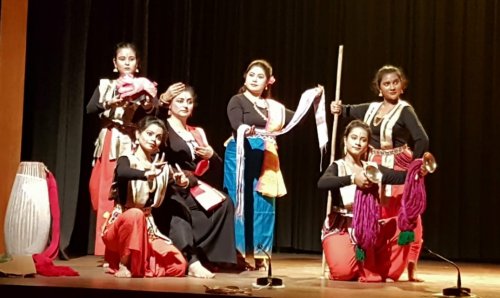 Poushali Chatterjee and group Parichay in Manipuri by Poushali Chatterjee and her group followed next. Consistent with the theme of the evening, her presentation was a profound search for identity wherein she tried to explore why she danced, how important the danced characters were to her and how it helped her to answer the question, who she was. While creating Parichay, she came to recognize both the world of her work as well as the world of dance wherein she was immersed. The different forms of Manipuri dance used were the classical form Jagoi, the ancient ritualistic folk dance Lai Haraoba, the martial arts Thang ta, as well as Cholom used in Sankirtana including playing of pung, the Manipuri drum. The music was put together by Debashish Ghosh and curated from different musical compositions of Guru Bipin Singh, Ojha Nitiken Singh, Yumnam Bhumeshwar Singh and Anindya Bandyopadhyay. Performance by Poushali Chatterjee and her talented group -- drawing inspiration from different mythical and historical characters -- was quite arresting. 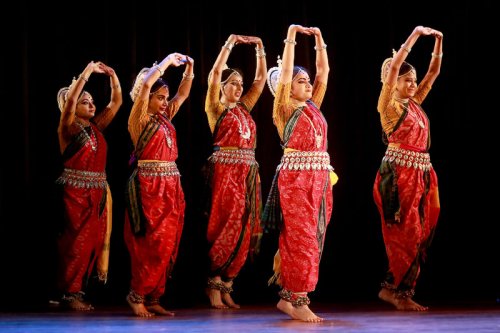 Arpita Venkatesh and group Natyam Sugitam Vaditram, the fifth and final item was provided in Odissi by Arpita Venkatesh and her group, with music by Sukhomoy Bhattacharya. Again, going to the basics, Arpita fell back on Natya Shastra, India's - and perhaps the world's --first treatise on performing arts and aesthetics, and drew deep her inspiration from narratives on musical instruments (chapter 28 onwards): tat (string), sushi (flute), ghana (solid) and avanaddha (skin-covered). Gandharva Vidya, which all the gods and goddesses were immensely fond of, is based on swara, tala and pada. Swara comes from the instrument veena and kantha (human voice); flute produces swara as well. On the other hand, ghana and avanaddha maintain certain beats that provide rhythm. The group presented an enticing Odissi choreography based on this unique concept in an aesthetic milieu of instruments, derived entirely from Natya Shastra. It was a befitting finale to an interesting theme of the evening.  Dr. Utpal K Banerjee is a scholar-commentator on performing arts over last four decades. He has authored 23 books on Indian art and culture, and 10 on Tagore studies. He served IGNCA as National Project Director, was a Tagore Research Scholar and is recipient of Padma Shri. Post your comments Please provide your name and email id when you use the Anonymous profile in the blog to post a comment. All appropriate comments posted with name and email id in the blog will also be featured in the site. |